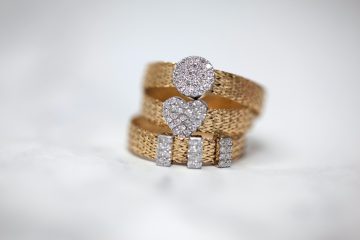Pearls can be completely genuine or cultured and any shape or color. Due to the pollution of the seas and the destruction of the seabed, it is becoming increasingly difficult to obtain fine pearls from saltwater mussels, and prices have therefore skyrocketed to saltwater pearls.
Completely authentic, naturally occurring pearls are now incredibly rare.
If you take saltwater beads against the teeth, they feel “matte”.
Genuine pearls – Orient pearls
The truly authentic pearls are nowadays called oriental pearls.
No matter what shape or size it is, to say the least, difficult to get hold of today. If you want to get hold of such, you have to look for auctions for jewelry from the 19th century.
Pearl colors
Both cultured and genuine saltwater pearls can have slightly different colors. These colors are usually natural, as the precious saltwater pearls are very rarely dyed.
The beads can be completely white, pinkish, champagne, gray, or almost black.
A natural black gem is very, very valuable.
The very smallest oriental beads, up to only two millimeters, are called seed pearls or seed beads.
These were usually stitched on threads which were then braided in intricate lace patterns to tightly seated necklaces.
Smuggled Beads
The pearl industry is very strictly controlled to ensure that the cultured pearls are of good quality. But it seems that growers leave the pearls for less than three years, and then these pearls are smuggled out to the international market. The beads do not have the same luster at all and can easily break.
Cultured pearls
When you just say “cultured pearls” you almost always refer to saltwater pearls.
The most common cultivated pearls come from Japan and are sometimes called Akoya pearls after the name of the mussel they are grown in. This cultivation of pearls has been going on since the early 1900s.
Here you make sure that it becomes a pearl in the mussel by operating a pearl ball in the mussel. The mussel then encapsulates the ball with several thousand layers of bead material. After about three years, the layer is about 0.5 mm thick, and the finished pearl is then removed. The most common size of the beads is 6 – 7 mm.
Really large cultured pearls, sometimes up to 20 mm, are grown in special mussels in the sea north of Australia and around Tahiti. These pearls are white or natural blue-gray with an incredible glow.
These beads are today the finest you can get.
Different shapes of pearls
The most common thing is that a pearl is round, but since it is a living process to obtain the pearls, nature often allows them to take other more imaginative forms.
Baroque pearls – These beads are a bit uneven in shape.
The roughness may be small or very large, but all fall under the term baroque beads.
Often a Baroque pearl has a much more vibrant surface and a more beautiful and interesting shimmer than a regular round pearl.
Bouton pearls – These are slightly compressed and button-shaped and the name comes from the French word bouton = button.



